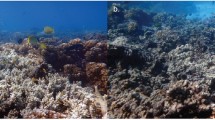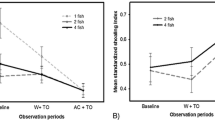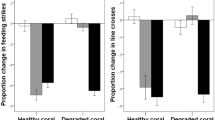Abstract
Prey that are capable of continuously learning the identity of new predators whilst adjusting the intensity of their responses to match their level of risk, are often at a substantive advantage. Learning about predators can occur through direct experience or through social learning from experienced individuals. Social learning provides individuals with an effective means of acquiring information while reducing the costs associated with direct learning. Under a natural setting, social learning is likely to occur between more than two individuals. As such, investigating the effect that group size has on the ability of individuals to acquire information is vital to understanding social learning dynamics. Given the characteristics of coral reefs and the biology of coral reef fishes, these habitats are an ideal medium to test whether group size affects the transmission of information. Using newly settled damselfish (Pomacentrus amboinensis), we examined whether the number of observers present influences transmission of information. We showed that: (1) predator recognition is socially transmitted from predator-experienced to predator-naïve individuals regardless of group size, and that (2) the level of response displayed by the observer does not differ following learning in different sized groups. Our study highlights that information on predator identities is able to be passed onto group members quickly without a dilution of information content.

Similar content being viewed by others
References
Berejikian BA, Tezak EP, LaRae AL (2003) Innate and enhanced predator recognition in hatchery-reared chinook salmon. Environ Biol Fish 67:241–251
Blumstein DT, Evans CS, Daniel JC (1999) An experimental study of behavioural group size effects in tammar wallabies, Macropus eugenii. Anim Behav 58:351–360
Bradbury JW, Vehrencamp SL (1998) Principles of animal communication, 1st edn. Sinauer Associates Inc., Massachusetts
Brown GE (2003) Learning about danger: chemical alarm cues and local risk assessment in prey fishes. Fish Fish 4:227–234
Brown C, Laland KN (2003) Social learning in fishes: a review. Fish Fish 4:280–288
Brown GE, Chivers DP (2006) Learning about danger: chemical alarm cues and predation risk assessment by fishes. In: Brown C, Laland K, Krause J (eds) Fish cognition and behaviour. Blackwell Scientific Publisher, Oxford, pp 49–69
Brown C, Laland KN, Krause J (2011) Fish cognition and behavior, 2nd edn. Blackwell Scientific Publisher, Oxford
Chivers DP, Ferrari MCO (2014) Social learning of predators by tadpoles: does food restriction alter the efficacy of tutors as information sources? Anim Behav. doi:10.1016/j.anbehav.2013.12.018
Chivers DP, Smith RJF (1994) Fathead minnows, Pimephales promelas, acquire predator recognition when alarm substance is associated with the sight of unfamiliar fish. Anim Behav 48:597–605
Chivers DP, Smith RJF (1995) Free-living fathead minnows rapidly learn to recognize pike as predators. J Fish Biol 46:949–954
Chivers DP, Smith RJF (1998) Chemical alarm signaling in aquatic predator–prey systems: a review and prospectus. Ecoscience 5:338–352
Chivers DP, Kiesecker JM, Marco A, Wildy EL, Blaustein AR (1999) Shifts in life history as a response to predation in western toads (Bufo boreas). J Chem Ecol 25:2455–2463
Chivers DP, Dixson DL, White JR, McCormick MI, Ferrari MCO (2013) Degradation of chemical alarm cues and assessment of risk throughout the day. Ecol Evol 3:3925–3934
Crane AL, Ferrari MCO (2013) Social learning of predation risk: a review and prospectus. In: Clark K (ed) Social learning theory: phylogenetic considerations across animal, plant, and microbial taxa. Nova Science Publisher, New York, pp 53–82
Dixson DL, Munday PL, Jones GP (2010) Ocean acidification disrupts the innate ability of fish to detect predator olfactory cues. Ecol Lett 13:68–75
Duffy GA, Pike TW, Laland KN (2009) Size-dependent directed social learning in nine-spined sticklebacks. Anim Behav 78:371–375
Feeney WE, Lönnstedt OM, Bosiger Y, Martin J, Jones GP, Rowe RJ, McCormick MI (2012) High rate of prey consumption in a small predatory fish on coral reefs. Coral Reefs 31:909–918
Ferrari MCO, Chivers DP (2006) Learning threat-sensitive predator avoidance: how do fathead minnows incorporate conflicting information? Anim Behav 71:19–26
Ferrari MCO, Chivers DP (2008) Cultural learning of predator recognition in mixed-species assemblages of frogs: the effect of tutor-to-observer ratio. Anim Behav 75:1921–1925
Ferrari MCO, Trowell JJ, Brown GE, Chivers DP (2005) The role of learning in the development of threat-sensitive predator avoidance by fathead minnows. Anim Behav 70:777–784
Ferrari MCO, Wisenden BD, Chivers DP (2010) Chemical ecology of predator–prey interactions in aquatic ecosystems: a review and prospectus. Can J Zool 88:698–724
Ferrari MCO, Manassa RP, Dixson DL, Munday PL, McCormick MI, Meekan MG, Sih A, Chivers DP (2012) Effects of ocean acidification on learning in coral reef fishes. PLoS ONE 7:e31478
Galaf BG, Giraldeau LA (2001) Social influences on foraging in vertebrates: cause mechanisms and adaptive functions. Anim Behav 61:3–15
Galef BG, Laland KN (2005) Social learning in animals: empirical studies and theoretical models. Bioscience 55:489–499
Godin JGJ, Classon LJ, Abrahams MV (1988) Group vigilance and shoal size in a small characin fish. Behaviour 104:29–40
Griffin AS (2004) Social learning about predators: a review and prospectus. Learn Behav 32:131–140
Heyes CM (1994) Social learning in animals: categories and mechanism. Biol Rev 69:207–231
Holmes TH, McCormick MI (2009) Influence of prey body characteristics and performance on predator selection. Oecologia 159:401–413
Hoverman JT, Auld JR, Relyea RA (2005) Putting prey back together again: integrating predator-induced behavior, morphology, and life history. Oecologia 144:481–491
Kerrigan BA (1996) Temporal patterns in size and condition at settlement in two tropical reef fishes (Pomacentridae: Pomacentrus amboinensis and P. nagasakiensis). Mar Ecol Prog Ser 135:27–41
Laland KN, Williams K (1997) Shoaling generates social learning of foraging information in guppies. Anim Behav 53:1161–1169
Lima SL (1998) Nonlethal effects in the ecology of predator–prey interactions. Bioscience 48:25–34
Lima SL, Zollner PA, Bednekoff PA (1999) Predation, scramble competition, and the vigilance group size effect in dark-eyed juncos (Junco hyemalis). Behav Ecol Sociobiol 46:110–116
Lönnstedt OM, McCormick MI, Meekan MG, Ferrari MCO, Chivers DP (2012) Learn and live: predator experience and feeding history determines prey behaviour and survival. Proc R Soc Lond B 279:2091–2098
McCormick MI, Holmes TH (2006) Prey experience of predation influences mortality rates at settlement in a coral reef fish. J Fish Biol 68:969–974
McCormick MI, Manassa RP (2008) Predation risk assessment by olfactory and visual cues in a coral reef fish. Coral Reefs 27:105–113
McCormick MI, Meekan MG (2007) Social facilitation of selective mortality. Ecology 88:1562–1570
Manassa RP, McCormick MI (2012) Social learning and acquired recognition of a predator by a marine fish. Anim Cogn 15:559–565
Meekan MG, Wilson SG, Halford A, Retzel A (2001) A comparison of catches of fishes and invertebrates by two light trap designs, in tropical NW Australia. Mar Biol 139:373–381
Mitchell MD, McCormick MI, Ferrari MCO, Chivers DP (2011a) Coral reef fish rapidly learn to identify multiple unknown predators upon recruitment to the reef. PLoS ONE 6:e15764
Mitchell MD, McCormick MI, Ferrari MCO, Chivers DP (2011b) Friend or foe?: the role of latent inhibition in predator and non-predator labelling by coral reef fishes. Anim Cogn 14:707–714
Reebs SG (2000) Can a minority of informed leaders determine the foraging movements of a fish shoal? Anim Behav 59:403–409
Sih A, Ziemba R, Harding KC (2000) New insights on how temporal variation in predation risk shapes prey behaviour. Trends Ecol Evol 15:3–4
Valone TJ, Templeton JJ (2002) Public information for the assessment of quality: a widespread social phenomenon. Phil Trans R Soc B 357:1549–1557
Vilhunen S, Hirvonen H, Laakkonen MVM (2005) Less is more: social learning of predator recognition requires a low demonstrator to observer ratio in Arctic charr (Salvelinus alpinus). Behav Ecol Sociobiol 57:275–282
Wiebe KL (2004) Innate and learned components of defence by flickers against a novel nest competitor, the European starling. Ethology 110:779–791
Wisenden BD (2000) Olfactory assessment of predation risk in the aquatic environment. Phil Trans R Soc B 355:1205–1208
Zhao X, Chivers DP (2005) Response of juvenile goldfish (Carassius auratus) to chemical alarm cues: relationship between response intensity, response duration, and the level of predation risk. In: Mason RT, LeMaster M, Muller-Schwarze D (eds) Chemical signals in vertebrates, volume 10. Plenum Press, New York, pp 334–341
Acknowledgments
Special thanks to O. Lönnstedt, J. White and R. Brooker for assistance in the field and the Australian Museum Lizard Island Research Station for providing logistical support and facilities. Thanks to P. Manassa for his artistic contribution and R. Manassa for his continued support. This study was funded through the ARC Centre of Excellence for Coral Reef Studies.
Ethical standards
The experiment was performed in accordance with the National Health and Medical Research Council, Australian Code of Practice for the Care and Use of Animals for Scientific Purposes 7th Edition, 2004: (the Code) and in compliance with the Queensland Animal Care and Protection Act, 2001 (Act no. 64 of 2001; he Act) and James Cook University guidelines under approval A1067.
Author information
Authors and Affiliations
Corresponding author
Additional information
Communicated by C. M. Garcia
Rights and permissions
About this article
Cite this article
Manassa, R.P., McCormick, M.I., Dixson, D.L. et al. Social learning of predators by coral reef fish: does observer number influence acquisition of information?. Behav Ecol Sociobiol 68, 1237–1244 (2014). https://doi.org/10.1007/s00265-014-1734-7
Received:
Revised:
Accepted:
Published:
Issue Date:
DOI: https://doi.org/10.1007/s00265-014-1734-7




